PDF of this article (210 KB)
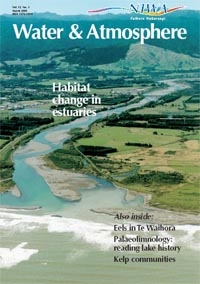
Ian Hawes Wendy Nelson Steve Mercer
Lessonia variegata is the dominant kelp on many wave-exposed New Zealand rocky reefs. How does this plant do so well in such rough conditions?
The trade-offs of life in a kelp forest in the ocean are a little like those in forests on land. To be a winner you need to get your photosynthetic tissues up into the canopy and make space for yourself. But the bigger you get the more vulnerable you are to catastrophe during violent storms. At the same time, those losses of canopy plants provide a hole where new-generation plants can grow.
The kelp Lessonia variegata flourishes where conditions are rough. Thick forests, dominated by Lessonia, are found on rocky reefs along some of our most exposed shorelines, from below low tide to 15 to 20 m deep. A wide range of plants and animals depend on Lessonia for habitat, food or shelter. Lessonia is therefore a key habitat-forming species in rocky reefs. Learning more about species like L. variegata is a good way to start understanding the rocky reef community as a whole.
Kelp: a difficult subject
The very conditions that favour Lessonia – strong surges and big swells – make the community hard to study. Divers can work in Lessonia forests only in calm weather and it is not possible to employ many of the methods we can use in sheltered waters. Perhaps because of these difficulties we know very little about this abundant and widespread alga.
In our project to study kelp, high-tech approaches are out, so we are going back to basics: demography (population structure) and morphometrics (shape). We sometimes forget how much can be learnt, and how important research questions can be guided, from these old-fashioned sciences. Our first results are already providing some clues about Lessonia’s survival strategy.
Lessonia structure
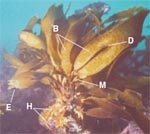
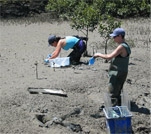
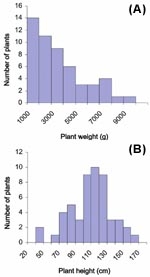
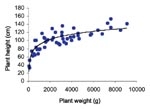
A Lessonia plant is made up of three main parts: a holdfast, which secures the plant to the rock beneath it; the stems, known as stipes; and long, strap-like blades.
Lessonia grows from the meristem, a small, dark-coloured region of rapidly dividing cells at the top of the stipe and the base of the blade (see first photo). As the new cells expand, the blade and stipe grow longer. The oldest part of the blade is therefore at the tip, which gradually erodes away. This means that there is a limit to the length of the blades.
Every now and again, the meristem divides in two longitudinally (lengthwise) to form Y-shaped branches (see second photo). At the base of the plant, the forking stipes end in a massive holdfast. The holdfast branches too, sending out thick root-like haptera to increase the area of attachment. The haptera are vital because hanging on to the rock is a high priority in a location exposed to waves.
The kelp community
In our first look at the structure of a Lessonia community we simply weighed and measured the plants collected from a 5 x 5 m area of closed Lessonia canopy off the south coast of Wellington.
The histograms (first graph) show that plant weights (or biomass) and heights are distributed quite differently. For biomass, most plants are in the lower weight categories and there are progressively fewer plants in the heavier categories. For plant height, there are very few short plants and very few tall plants, but most are in the middle categories. Plotting weight against height (second graph) shows that all plants except the very lightest and the very heaviest are around 1–1.2 m tall.
We also found that found that the size of an individual blade was similar in all plants, regardless of weight. Since the blades make up most of the plant height, this explains how plants with very different biomasses can be the same height. The way a kelp plant gets tall is to extend a long blade from the meristem, but the way it increases its biomass is to form branches. Old plants are those with many branches and many blades, not necessarily those that are longest.
Getting bigger is good for a Lessonia plant because it increases the area available for photosynthesis and nutrient uptake. The downside is that increasing the number of blades also increases drag on the plant. So the plants must invest in stronger stipes and holdfasts at the same time. This is exactly what we found: as the plant gets bigger, the proportions of a plant made up of blade, stipe and holdfast stay remarkably constant.
More questions
This simple analysis of the growth strategy of Lessonia has led to some questions for the next stage of this research programme. How often do the meristems divide? How fast do the stipes extend? Knowing this will help us understand the age structure of communities, and longevity and growth rates in plants.
We plan to continue using simple methods so that the work can be accomplished by divers working in very difficult conditions. For example, we can tag individual plants so that their growth can be measured. We can track blade growth by punching tiny holes in the blades at fixed distances from the meristem and measuring how fast this distance increases as the blade grows.
Experiments are also possible to investigate, for example, recovery from disturbance. How quickly do plants move in to replace those lost when the canopy is disrupted? How important is the size of the gap to the rate of recolonisation? At present we are establishing study sites within the Lessonia canopies where we can set up controlled experiments on regeneration of disturbed canopies, and where we can mark individual plants and follow their growth and development over long periods.
Answering these questions will help us to understand how rapidly the kelp forest grows, as well as its resilience and resistance to change in growth conditions or extreme weather. It is only by setting up long-term studies that we can fully understand the dynamics of these long-lived plants – and only by careful preliminary analysis that we can design the right studies.
Teachers: this article can be used for NCEA Achievement Standards in Biology (1.7, 2.5, 2.7, 2.8, 3.5), Science (2.2). See other curriculum connections at www.niwa.co.nz/pubs/wa/resources
Ian Hawes is based at NIWA in Hamilton; Wendy Nelson and Steve Mercer are at NIWA in Wellington.
